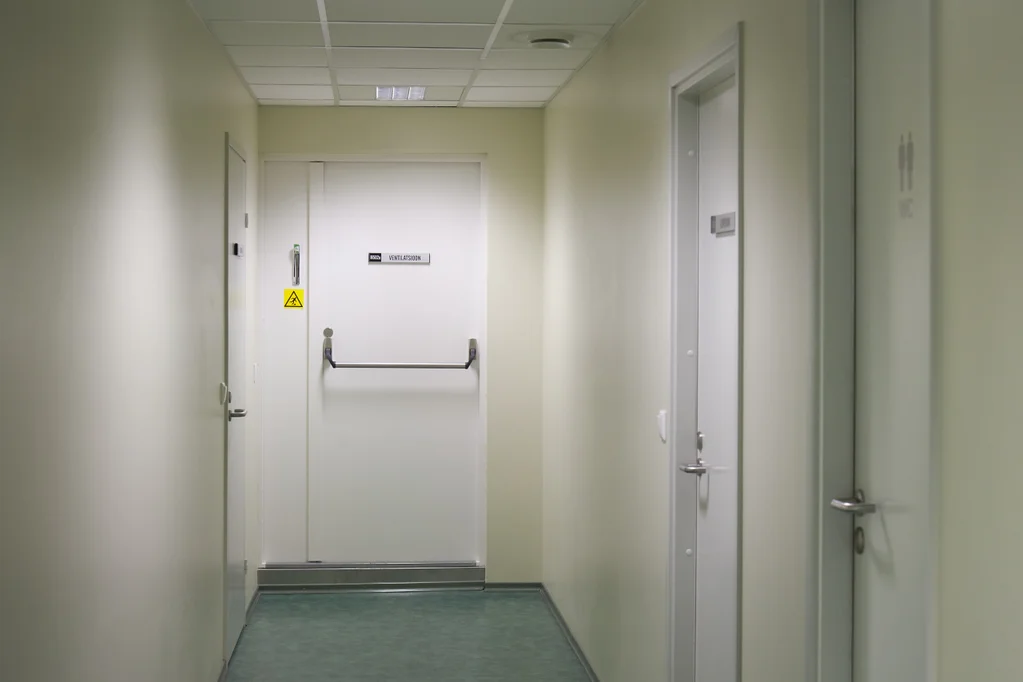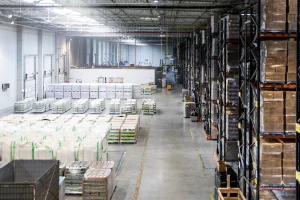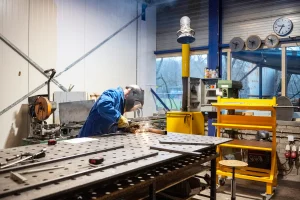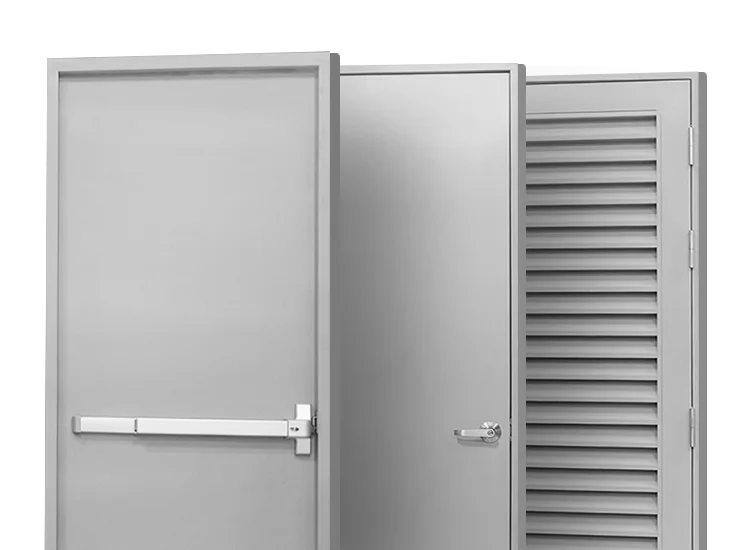Steel doors are known for their strength, fire resistance, and durability. Even so, not all are built to the same standard. A “heavy-duty” label or “fire-rated” seal doesn’t guarantee top performance. The truth? Not all steel doors are made equal, and that the differences in steel types, fabrication methods, and compliance can mean the difference between years of reliable service and costly replacements.
For procurement professionals in government, corporate, or high-traffic commercial sectors, buying steel doors isn’t just a purchase; it’s also an investment in safety, compliance, and value for money. Choosing the wrong product can lead to failed inspections, security vulnerabilities, or expensive retrofits.
This article walks you through the essentials—from understanding the basics of steel door manufacturing to spotting the latest innovations—so you can make informed purchasing decisions that meet your standards.
What is Steel Door Manufacturing?
Steel door manufacturing is the process of designing, fabricating, and assembling doors primarily from steel to deliver exceptional security, durability, and fire resistance. Widely used in residential, commercial, and industrial buildings, these doors boast of long-term performance and prioritize safety above all else.
Compared to wood or fiberglass, steel doors offer superior strength, a longer lifespan, and resistance to harsh weather conditions. Many steel doors are insulated to improve energy efficiency, keeping indoor temperatures stable and reducing heating or cooling costs. They also provide reliable protection against break-ins, tampering, and extreme events such as hurricanes or high-impact collisions.
Most models are fire-rated and require minimal upkeep since they resist warping, rotting, and fading. These, in turn, make them a cost-effective investment over time. For procurement professionals balancing quality standards with budget constraints, the right steel door can deliver decades of service with minimal maintenance, provided the material and manufacturer are carefully chosen.
Common Steel Types Used in Manufacturing Steel Doors
The type of steel used plays a major role in determining a door’s performance, durability, and cost. Each variant offers distinct advantages and trade-offs, making it important to match the material to the project’s environment and requirements.
Cold-Rolled Steel
Often used for interior doors and lightweight commercial or exterior applications. Its smooth finish, precision shaping, and cost-effectiveness make it a popular choice. However, it offers less corrosion resistance than galvanized steel, so it’s better suited for dry indoor environments or areas with minimal exposure to the elements.
Hot-Rolled Steel
Hot-rolled steel is a go-to for heavy-duty industrial doors. It is strong, durable, and budget-friendly for bulk orders. The trade-off is a rougher surface that usually requires additional processing or finishing to meet architectural standards.
Stainless Steel
The premium option, stainless steel is ideal for high-end architectural projects and coastal applications where corrosion resistance is essential. Its sleek, modern look adds aesthetic appeal, but it comes at a higher cost and is heavier than other options.
Galvanized Steel
Galvanized steel is widely considered the best cost-to-quality choice, especially for exterior, security, and fire-rated doors. A zinc coating protects against rust and corrosion, ensuring long life and low maintenance. While it performs well in most environments, it may be less suitable for highly acidic or extreme heat conditions.
Among these, galvanized steel stands out, and for good reason. For procurement teams looking for long-term value with minimal upkeep, galvanized steel offers the most balanced solution—delivering durability, weather resistance, and cost efficiency in one package.

How Steel Doors are Manufactured from Start to Finish
Manufacturing a steel door is a careful blend of engineering precision, strict quality controls, and skilled craftsmanship. The process ensures that each door not only meets safety and durability requirements but also delivers the desired aesthetic and functional features.
1. Material Selection
It begins with material selection: choosing the right type of steel for the project’s needs. Galvanized steel is often selected for its durability, stainless steel for premium and corrosion-prone environments, and cold-rolled steel for precision builds.
2. Design and Engineering
Next is the design and engineering phase. Using CAD software, engineers draft exact specifications, planning for security features, insulation layers, and hardware placements to ensure the final product meets both functional and compliance standards.
3. Steel Sheet Cutting and Forming
The chosen steel is then cut and formed. Large steel coils are sliced into sheets, which are shaped into frames and panels using press brakes and rollers. This shaping process ensures each part of the door is perfectly aligned for assembly.
4. Reinforcement and Welding
Reinforcement and welding follow, where structural supports are integrated into the frame. Hinges and lock preparations are welded into place, ensuring strength and security from the start.
5. Surface Treatment
Before assembly, the steel undergoes a surface treatment. For galvanized doors, this means applying a protective zinc coating to resist rust. Additional finishes, such as powder coating or paint, enhance durability while offering aesthetic customization.
6. Insulation and Core Filling
For improved thermal and sound performance, the door is then insulated and core-filled. Depending on the application, polyurethane or polystyrene foam is added for energy efficiency, while fire-rated models may use mineral wool cores for added safety.
7. Assembly and Hardware Installation
Once all components are ready, assembly and hardware installation take place. Frames, panels, and cores are fitted together, and hardware such as handles, locks, or smart lock systems is installed.
8. Quality Testing
Finally, each door undergoes quality testing. This includes stress, fire, and impact resistance trials, along with compliance checks for standards like ANSI, UL, or ASTM. Only doors that pass these rigorous inspections are approved for delivery.
Innovations Transforming the Steel Door Manufacturing Industry
The industry is rapidly evolving with technology-driven and eco-friendly advancements, changing building codes, and growing demands for both performance and design flexibility. These innovations are not only improving the functionality and durability of steel doors but also expanding their role in modern architecture and construction.
Smart Lock Integration
Today’s steel doors are increasingly built with advanced lock systems in mind, moving beyond traditional keyed mechanisms. Manufacturers are designing doors that seamlessly accommodate biometric scanners, RFID access cards, and Bluetooth-enabled locks. This integration supports higher levels of security while offering convenience for both commercial and residential users. For procurement teams, this means fewer retrofits and better compatibility with modern security infrastructure from the start.
Energy-Efficient Designs
Thermal efficiency is no longer just a selling point. Instead, it’s often a compliance requirement in new builds. Innovations such as thermal break technology, where insulating barriers are placed within the steel frame, significantly reduce heat transfer. Coupled with high-performance core materials like polyurethane foam, these designs help lower energy costs while improving interior comfort. In high-energy-cost regions, this feature directly impacts a building’s operational expenses.
Eco-Friendly Manufacturing
Sustainability is a growing priority in construction, and steel door manufacturers are responding with greener production methods. This includes using recycled steel in fabrication, adopting powder coating systems that emit fewer volatile organic compounds (VOCs), and optimizing cutting processes to minimize material waste. Such approaches not only reduce environmental impact but also align with green building certifications like LEED.
Custom Finishes
Steel doors are no longer purely utilitarian. Modern manufacturing techniques allow for a variety of finishes, from laser-cut patterns and embossed textures to wood-grain effects that mimic natural timber. These options give architects and designers greater freedom to match doors with the overall style of a building, whether it’s a sleek corporate headquarters or a heritage restoration project.
Enhanced Fire and Impact Resistance
Recent innovations in core materials and frame construction have elevated safety standards. Advanced mineral wool cores can withstand extreme heat for longer durations, while reinforced frame systems improve impact resistance against forced entry or debris during severe weather. These improvements are particularly valuable for facilities in high-risk environments such as coastal areas or industrial zones.
Collectively, these advancements are reshaping how steel doors are perceived—not just as barriers, but as multifunctional components of a building’s safety, efficiency, and design.
Tips for Choosing the Right Steel Door Manufacturer
Selecting the right manufacturer is crucial to ensuring your steel doors meet safety, durability, and compliance requirements. The decision goes beyond just price—it affects the long-term performance, maintenance needs, and overall value of your investment. Here’s what procurement teams should evaluate when making their choice:
Certifications and Compliance
For projects with strict fire safety requirements, verify that the manufacturer can provide fire rating certifications in line with the Philippine Fire Code (RA 9514). These credentials demonstrate that their products have undergone rigorous testing and meet all necessary regulatory benchmarks.
Material Quality
The steel type and finish play a major role in performance. Galvanized steel offers excellent corrosion resistance and low maintenance, making it ideal for high-humidity or coastal areas, while stainless steel provides superior durability and aesthetics for premium applications. A trustworthy manufacturer will not only disclose the exact material specifications but also explain why those materials are suitable for your project’s environment and intended use.
Manufacturing Transparency
A reliable manufacturer should be willing to walk you through their production process—whether through on-site visits, virtual tours, or detailed documentation. This transparency allows you to assess whether their methods, welding techniques, and finishing processes meet industry standards. Open communication about sourcing, assembly, and quality control is a strong indicator of a manufacturer’s credibility.
Lead Times and Logistics
Time is often a critical factor in construction projects. The manufacturer should be capable of meeting tight schedules without compromising quality, and they should have the capacity to handle bulk orders efficiently. In the Philippines, a local distribution network is a major advantage, as it reduces shipping delays and simplifies after-sales support.
Price vs. Warranty
While competitive pricing is important, procurement teams should prioritize value over the lowest bid. Seek manufacturers that balance cost efficiency with a strong warranty—ideally a minimum of 10 years for both materials and workmanship. This warranty reflects the manufacturer’s confidence in their product’s durability and performance.
Customer Feedback and Track Record
Research the manufacturer’s reputation by checking customer testimonials, case studies, and third-party reviews. Consistent positive feedback on durability, design accuracy, and responsive customer service is a strong sign of reliability. Long-standing relationships with reputable clients can also signal the manufacturer’s ability to deliver consistently.
Relevant Industry Expertise
Choose a manufacturer with proven experience in your sector, whether it’s commercial, industrial, residential, or institutional projects. Familiarity with your industry’s unique requirements ensures that the doors will meet both functional needs and regulatory obligations. For example, a supplier experienced in high-security facilities will understand the importance of integrating advanced locking systems and reinforced frames.
Building Stronger Homes and Buildings with Quality Steel Doors
Procuring steel doors doesn’t have to be a complicated or risky process. With the right manufacturer, you can secure products that meet the highest standards for safety, performance, and longevity—while also aligning with your project’s budget and timeline.
At Janus Steel, every door we produce is the result of precise engineering, premium-grade materials, and strict compliance with global safety and quality benchmarks. Whether you need fire-rated security doors for high-occupancy buildings, heavy-duty industrial installations, or modern smart lock–ready designs, our products are built to deliver protection, functionality, and aesthetic appeal for years to come.
From material selection to final quality testing, our commitment is to provide solutions that perform in the real world—withstanding harsh weather, heavy use, and evolving security needs. The result? Doors that not only safeguard your spaces but also add long-term value to your projects.
Explore our steel door catalog or reach out to our team for a custom quote for the perfect solution that meets your exact requirements.





